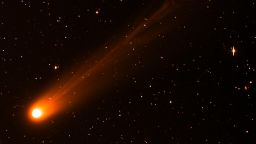An interstellar comet known as 3I/ATLAS has recently made its closest approach to the sun, coming within approximately 126 million miles (or 203 million kilometers) of our star. This event marks a significant moment for astronomers as the comet journeys back into the depths of space, yet it will remain within observational reach for several more months.
Currently positioned behind the sun from the perspective of ground-based telescopes, 3I/ATLAS will become visible again in the predawn sky around November 11, 2023, according to astronomer Darryl Seligman, an assistant professor at Michigan State University. As the comet approaches its closest point to Earth on December 19, 2023, it will come within about 168 million miles (or 270 million kilometers) of our planet. Notably, the European Space Agency has confirmed that this distance poses no threat to Earth.
Discovered on July 1, 2023, 3I/ATLAS is only the third known interstellar object to pass through our solar system. Ongoing observations are crucial as they provide insights into how this comet differs from those originating in our own solar system. Comets are often described as “dirty snowballs,” composed of ice, dust, and rock. As they approach stars, the heat causes them to release gas and dust, forming their distinctive tails.
Astronomers are particularly interested in gathering data from 3I/ATLAS as it nears the sun. The material released during this phase can offer valuable information about its composition and the conditions of its original star system. Seligman emphasized the importance of these observations: “When it gets closest to the sun, you get the most holistic view of the nucleus possible.”
Various advanced instruments, including the Hubble Space Telescope and the James Webb Space Telescope, in addition to missions like SPHEREx, have been employed to study the comet. Recent data gathered by these telescopes indicated the presence of key substances, such as carbon dioxide, water, carbon monoxide, and water ice, being released as the comet approaches the sun.
Preliminary research suggests that 3I/ATLAS is between 3 billion and 11 billion years old, based on a study coauthored by Seligman and doctoral student Aster Taylor from the University of Michigan. For context, our solar system is estimated to be around 4.6 billion years old. Seligman noted that the comet’s composition suggests it has likely never been near another star before its encounter with the sun.
As the comet moved closer to the sun, it became less visible to ground-based telescopes in October. However, missions such as PUNCH (Polarimeter to Unify the Corona and Heliosphere) and SOHO (Solar and Heliospheric Observatory) have continued to track it. Notably, 3I/ATLAS made its closest approach to Mars on October 3, 2023, coming within 18.6 million miles (or 30 million kilometers) of the planet and its orbiting spacecraft.
Despite challenges posed by a government shutdown that hindered data sharing from NASA missions, the European Space Agency’s Mars Express and ExoMars Trace Gas Orbiter made attempts to capture images of the comet in October. The ExoMars orbiter succeeded in observing 3I/ATLAS as a faint dot, demonstrating the challenges of observing such distant objects.
Looking ahead, the ESA’s Jupiter Icy Moons Explorer (JUICE) is set to observe 3I/ATLAS in November, although the data is not expected to arrive until February due to transmission rates. Seligman expressed optimism about the continued observations, stating, “We’ve got several more months to observe it. And there’s going to be amazing science that comes out.”
As the scientific community anticipates further discoveries, the study of 3I/ATLAS offers an unprecedented opportunity to understand the nature of interstellar comets and the origins of the materials that populate our solar system.







